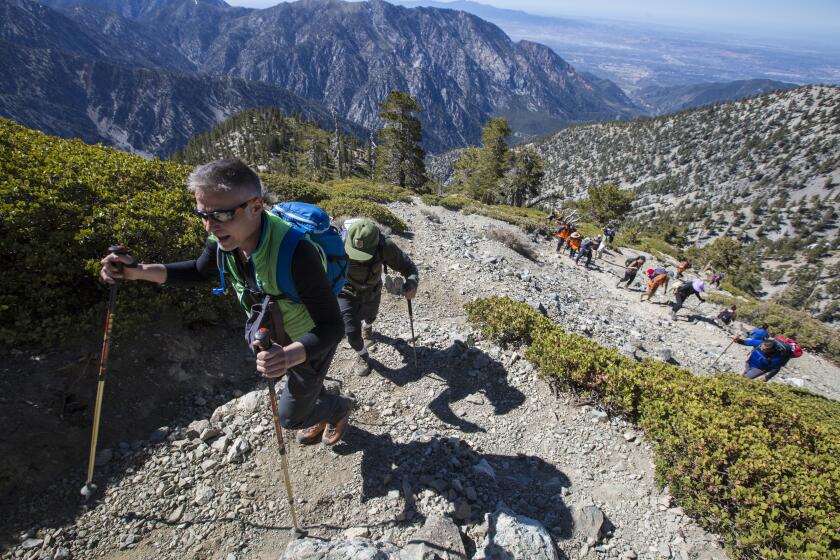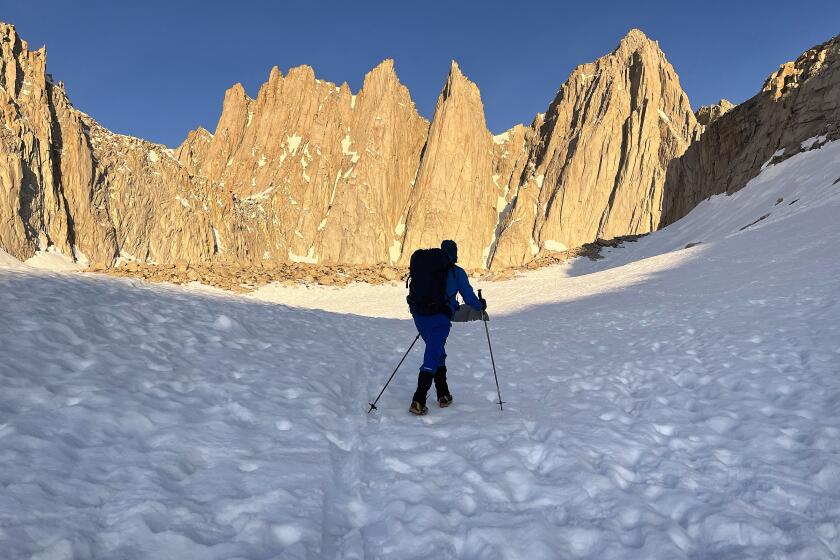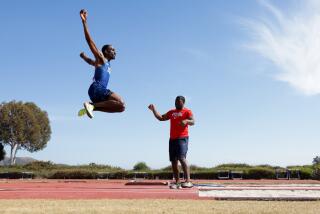Column One: A blind woman’s journey up a towering California summit
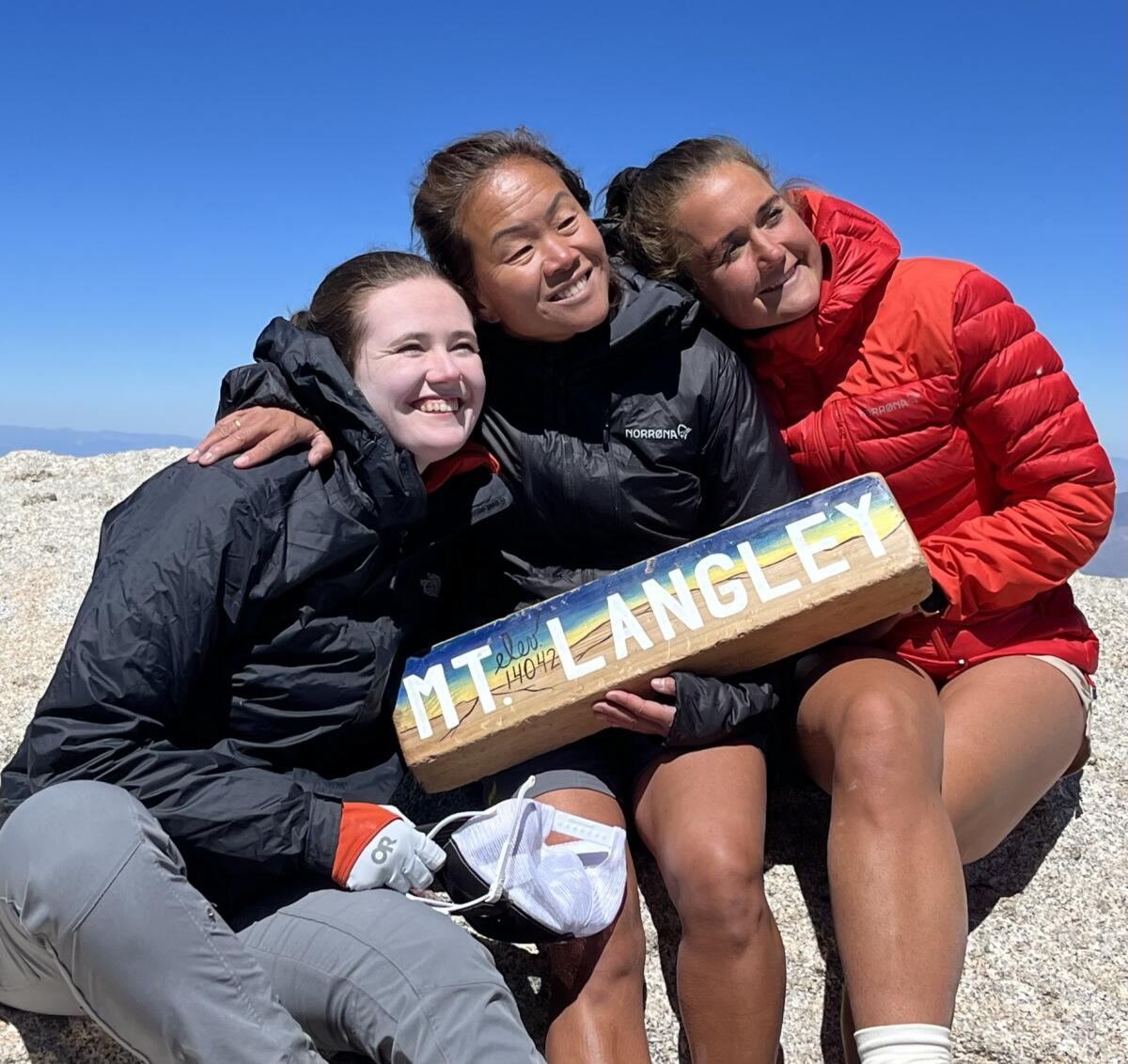
MT. LANGLEY'S SUMMIT, Calif. — As Eline Øidvin approached the top of Mt. Langley, a 14,000-foot colossus in California’s Eastern Sierra Nevada, she could feel the soft, sandy gravel beneath her feet. She could hear the enveloping silence of the barren landscape.
But she couldn’t see a thing. Not the craggy summit looking over the Owens Valley 10,000 feet below or the nearly vertical, several-hundred-foot drop that menaced just a few steps to the right.
Øidvin, who was born almost completely blind, would tell me later she was terrified as she matched strides with her guide, Therese Nordbø, keeping the lightest of grasps on Nordbø’s elbow. Øidvin concentrated on her own breath so she wouldn’t panic and start hyperventilating. But she was also thrilled to be on the brink of an accomplishment that previous generations might have regarded as impossible.
“I was just trying to keep calm, telling myself, ‘You can do this,’” Øidvin said.
At 46, Øidvin, a standout marathoner, was attempting her first serious mountain climb and doing it on one of California’s highest peaks. A mutual friend and longtime climbing buddy — we had climbed Mt. Kilimanjaro and Mt. Whitney together — had asked me to join the small group she would trust to guide her safely up and back.
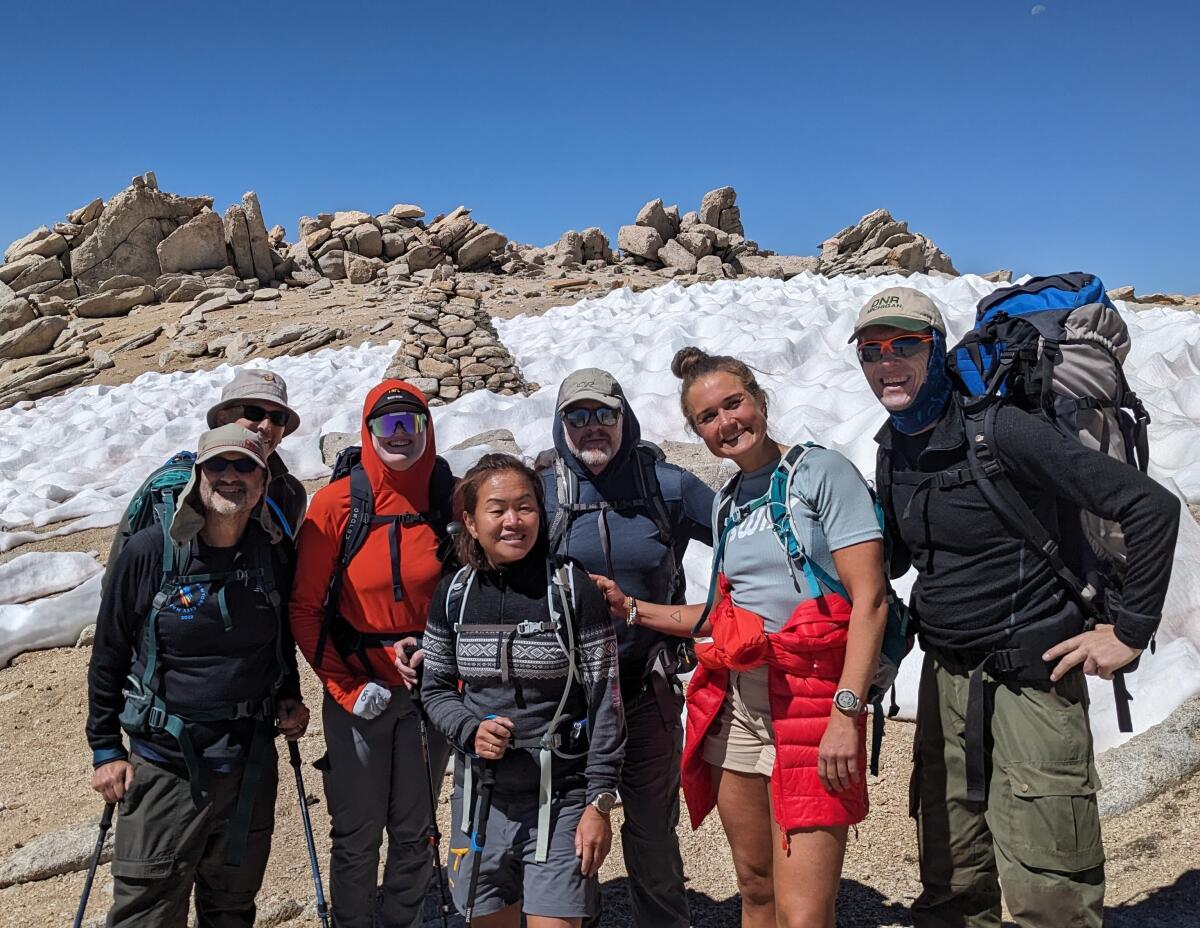
The idea seemed crazy to me at first. I understood that Øidvin was extremely fit, but I had never met her. I also knew that running on paved streets is one thing; climbing mountains — navigating over boulders, around downed trees and across cold streams — is entirely different.
Still, I’d been too curious to say no. And as we approached the summit beneath a brilliant blue September sky, I had to temper my own mix of exhaustion, anxiety and awe at what she was about to accomplish.
Øidvin is among a growing number of outdoor adventure athletes who refuse to let disabilities reduce them to spectators.
In recent years, blind athletes have run astonishingly fast marathons, scaled the towering sheer rock face of Yosemite’s El Capitan and climbed the “Seven Summits,” the highest peaks on each continent.
Erik Weihenmayer, 55, was the first blind person to reach the summit of Everest. His love of the outdoors began after a hereditary retina disease left him blind a week before his freshman year of high school.
It happened at an age when “you want so much to be part of the gang, you want so much to be cool,” Weihenmayer said, “and there I was being led in by my mobility instructor. I had to hold her elbow and let her lead me to class, to the bathroom.”
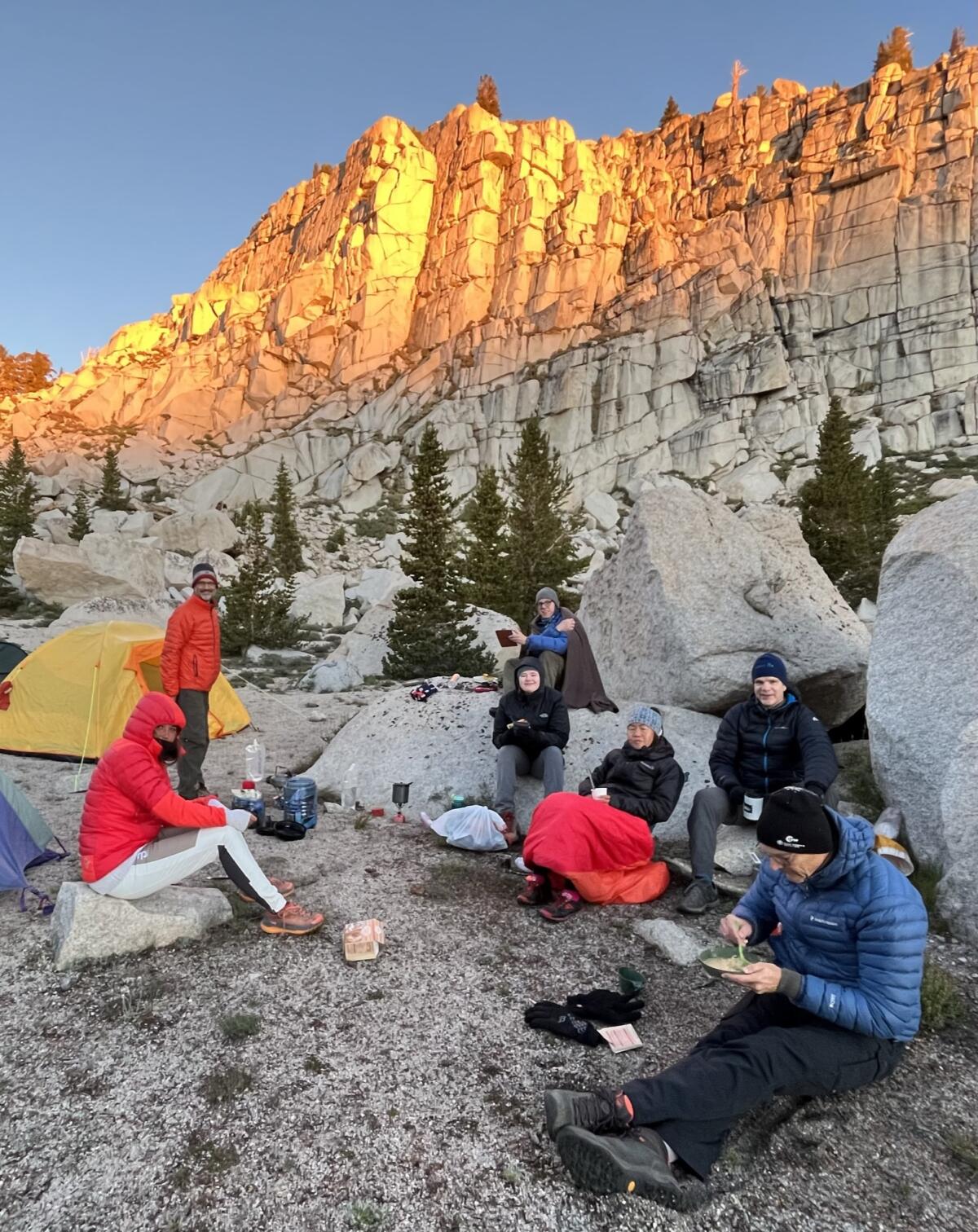
He remembers sitting alone in the cafeteria of his Connecticut high school because even former friends didn’t know how to act around him. “The thought of never being in the thick of things, and always being shoved to the sidelines and having a life with no adventure, no excitement, that was terrifying to me,” he said.
Since Weihenmayer couldn’t play ball sports, his dad signed him up with a group that took visually impaired people horseback riding, sailing and, one fateful weekend, rock climbing. As soon as he got on the wall and ran his hands and feet over the holds — like reading Braille with his fingertips — he was hooked.
“It was absolute engagement, absolute physical, emotional and spiritual connection with nature, and everything I wanted out of life,” said Weihenmayer, who now lives in Colorado.
It took Øidvin a couple of decades longer to discover her inner adventurer. But when she finally did, the transformation was just as profound.
Born in Korea and given up for adoption, she was taken in at the age of 3 months by a pair of schoolteachers who lived nearly 5,000 miles away in a remote village on the west coast of Norway.
Her early efforts to fit in with the other kids, to match their athletic exploits, didn’t go well. She’s completely blind in her right eye and has just a sliver of peripheral vision in her left. It’s like peeking through a keyhole, she said, and even then, she can only see things a few inches away.
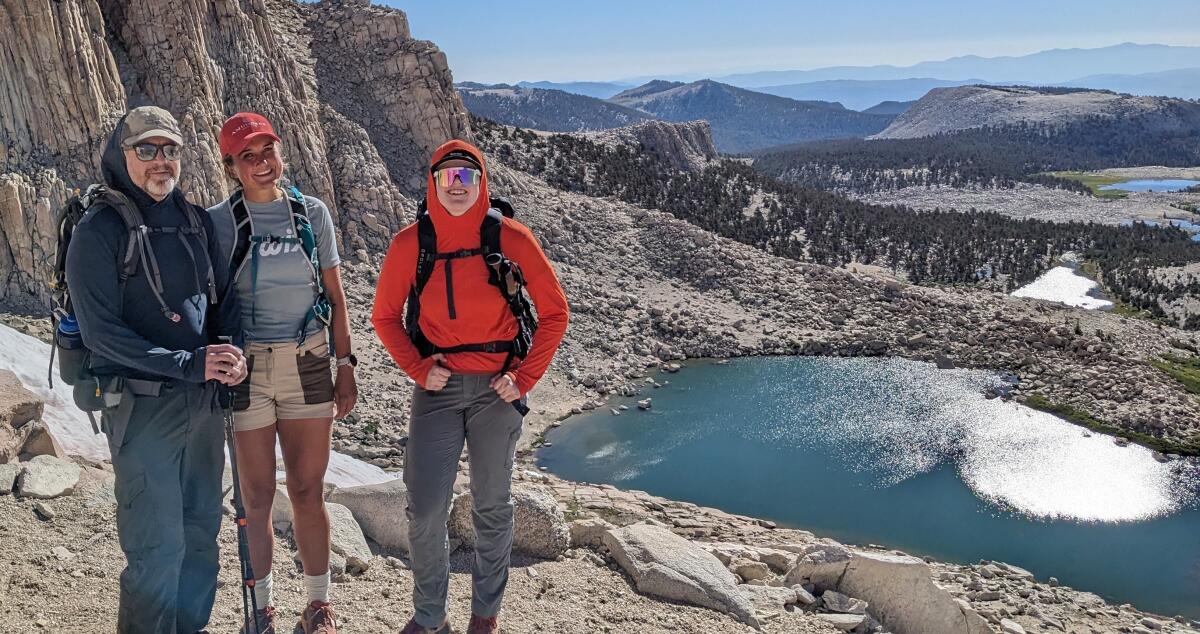
She signed up for soccer and handball at school but was “always running the wrong way and worried about getting hit by the ball,” she said with a laugh. Her insistence that her parents buy her a bicycle ended in frustration and bruises. “It wasn’t the smartest thing,” she admits.
“I really wanted to be like the other kids, and I really tried, but I could never succeed,” she said.
So she set her sporting dreams aside and got on with life: college, marriage, kids. She was working as a physical therapist in the village where she grew up when, on a work trip to Oslo, she bumped into a group of fellow conference attendees in the hotel lobby who were heading out for a run.
One of them, a doctor with experience guiding blind runners, insisted she come along. She was shy at first, didn’t want to slow everybody else down, but they wouldn’t take no for an answer. “Some of the best things in life just happen by coincidence,” Øidvin said.
The run went well, and not long after the doctor called to say an athlete he was supposed to guide in an upcoming half-marathon had backed out. He asked Øidvin to join him. She had never run more than four or five miles at that point and 13.1 miles would be a huge step up. Øidvin worried about making a fool of herself or wasting her new friend’s time.
“Don’t worry,” he assured her. “If we have to walk the last few miles, it’s no big deal.”
Øidvin ran every step of that race and won her division. It was her first taste of athletic success and a watershed moment. “It changed my life,” Øidvin said. “It completely changed how I thought about myself.”

Since then, she has traveled the globe, blowing away most of her visually impaired competition in 47 marathons, from New York, to Athens, to Barcelona. In 2015, she won her division in the Boston Marathon, one of the most celebrated and competitive races in the world.
It hasn’t always gone smoothly. When marathon organizers in Sacramento offered to pay her expenses to run in a field of visually impaired racers from around the world, she made the trip even though she felt as though she was getting a bad cold. She passed out moments after crossing the finish line and was rushed to a hospital, where doctors discovered she had pneumonia.
She doesn’t remember the end of the race, but one of her guides told her he got worried with a few miles to go and asked if she was OK. “No talking, just run!” she shouted.
At the Berlin Marathon, a race whose famously long, straight boulevards have led to 13 world records, Øidvin was on pace to run the fastest marathon of her life. With about six miles left, her guide suffered a sudden bout of diarrhea and had to dash for the porta-potties. Abandoned and unable to continue by herself, there was nothing Øidvin could do but stand in the street as precious seconds and hordes of slower runners passed by.
Her guide, guilt-stricken at the turn of events, abandoned modesty, kicked open the porta-pottie door from the inside and begged, in broken German, for someone to help Øidvin.
“He was sitting there on the toilet, with the door wide open, screaming,” Øidvin recalled. It worked. A runner with guiding experience appeared out of the crowd, offered his elbow, and off they went. She finished in 3 hours and 33 minutes, a personal best despite the delay.
That’s just how it goes, Øidvin said. Being blind creates obstacles other athletes don’t face, but it also brings out extraordinary grace and generosity in complete strangers.
The hikers who found actor Julian Sands’ remains in a remote canyon on Mt. Baldy in June are haunted by what was missing from his safety gear.
Her interest in the Sierra Nevada began when one of her most trusted marathon guides, Andy Lehren, who helped lead her to victory in Boston, told her about his climbs of Mt. Whitney and hikes among the towering pine trees and soaring granite walls in Yosemite. Øidvin said she wanted to give mountaineering a try, and Lehren, a friend of mine for nearly 30 years, asked if I would assist.
We assembled a team that included two friends from Seattle, both experienced mountaineers, and three Norwegians who have guided Øidvin in road races. We picked Mt. Langley, the most accessible of the giant peaks just west of Lone Pine, about four hours north of Los Angeles, because it’s mostly a long hike on a well-defined trail with only one brief section of mildly technical climbing.
The day before starting up Langley, we did a short acclimatization hike from about 8,000 to 9,000 feet on the flanks of Mt. Whitney. I had no idea how this was going to work until Øidvin placed her hand very lightly on my elbow and said, “Let’s go.”
As we ascended the initial switchbacks, I noticed she stuck her toes a little farther out in front than most people do with each stride. It was a subtle, and much more graceful, version of what the rest of us might do with our hands while searching for the light switch in a dark, unfamiliar hotel room.
At first, I warned her every time we approached a big step up or down. But it didn’t take long to realize she could usually sense the size and direction of each step by reading my body language, the clues transmitted through her fingers resting on my arm. The speed and ease with which she made these calculations was astonishing.
My biggest fear about taking her into the high alpine was the threat of thunderstorms. They can form quickly and turn a warm summer day into a freezing ordeal with rain, hail and thunder that sounds like artillery. Worse, there’s nowhere good to hide from the lightning above the tree line, so the safest option is to descend out of the clouds as quickly as possible.
Before I met Øidvin, I wondered how we would get her down fast enough in an emergency. After our first hike together, I wondered how I would keep up if she started running.
In addition to her remarkable ability to sense what was coming on the trail, she had an exceptional awareness of the landscape around us. She knew when trees were nearby, how tall they were and whether they had leaves or pine needles.
That’s due to a kind of sonar, sometimes called “echolocation,” honed by some visually impaired people, especially those who have been blind since birth. Øidvin said a friend with two glass eyes can snap his fingers in a strange room and tell you not only where the windows are but also how big they are.
“It’s not that I can hear better than you,” she told me. “I just pay more attention.”
Even without much snow, the standard spring hike to Mt. Whitney’s summit is a punishing ordeal. But in this year’s extraordinary conditions, it is a full-on winter mountaineering expedition, requiring serious gear and the expertise to use it.
The only thing that really scared her about the climb was the possibility of altitude sickness. She had never been above a few thousand feet and she worried how her body would react. Headaches and nausea are common for newcomers to the high mountains. Along with bad weather, they’re the most common reason people who are otherwise fit don’t make it to the summit.
That weighed on her, especially in the spooky lunar landscape above 12,000 feet, where there are no bushes or trees, just low-lying boulders and endless gravel. Above 13,000 feet, the trail disappears, turning the final push into a steep, tortuous slog up loose scree guided only by cairns — stone towers left by previous climbers to mark the way.
As we approached the summit and the vertigo-inducing cliff a few feet behind it, Øidvin couldn’t see how steep and long the drop was — “Lucky me!” she joked — but she knew it was there.
“I could feel it, and I could hear the emptiness,” she explained. She knew to be wary and to stick close to the rest of us. “I think I had the same feeling you had.”
But she didn’t let it stop her. Marathons had become sort of routine, she said, but climbing a 14,000-foot mountain was so wildly out of her comfort zone that it brought back the butterflies she felt in her stomach before that first half-marathon more than a decade ago.
She beamed as Nordbø guided her foot to the small, round metal disk embedded in the granite by the U.S. Geological Survey to mark the Mt. Langley summit.
“Life can be scary, but fear doesn’t help,” she told me later. “I’ve learned not to overthink these things.”
More to Read
Sign up for Essential California
The most important California stories and recommendations in your inbox every morning.
You may occasionally receive promotional content from the Los Angeles Times.
